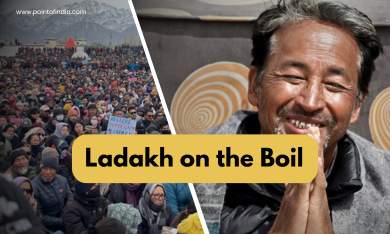Ladakh was carved into a Union Territory with hopes of better governance, autonomy, and environmental protection. But six years later, frustration has turned to anger.
On September 24, 2025, violent clashes broke out in Leh, leading to 4 deaths, injuries to over 70, and the imposition of curfew across the region. Protestors set fire to public offices, including the local BJP office and a CRPF vehicle.
Looking at this, the Central Government is now blaming renowned climate activist Sonam Wangchuk for the unrest. In response, Wangchuk has claimed that the government has ignored their peaceful approach, years of protests, and broken its promises.
So, what really happened in Ladakh? And why is this being referred to as a Gen Z uprising, like in Nepal?
Here are 10 key points to understand the full picture:
1. Why are people in Ladakh protesting?
In 2019, Ladakh became a Union Territory (UT) after Article 370 was abrogated and Jammu & Kashmir was bifurcated. Unlike J&K, Ladakh got no legislature — meaning no elected government or assembly.
Initially, the granting of Union Territory (UT) status to Ladakh in August 2019 was welcomed by many native Ladakhis, including climate activist and education reformer Sonam Wangchuk. The move was seen as a long-standing demand fulfilled, as it separated Ladakh from Jammu & Kashmir and gave it direct administration under the central government.
However, over time, the UT status has sparked growing resentment. Locals feel increasingly powerless, ignored, and underrepresented in decision-making, as Ladakh has no elected legislative assembly. The absence of local governance has intensified calls for Statehood, inclusion under the Sixth Schedule of the Constitution (to safeguard tribal land and culture), and Greater Protection of Tribal Rights.
2. Broken promises and dashed expectations
The Centre had assured Ladakhis that their culture, environment, and jobs would be protected. Yet, locals allege these promises remain unfulfilled. Outsiders are increasingly eyeing land and business opportunities, stoking fears of demographic change and loss of control over local resources.
3. Demand for Sixth Schedule protections
Ladakh’s population is over 95% tribal, making it eligible for protections under the Sixth Schedule of the Constitution, which would give locals authority over land and resources. Despite repeated assurances, the Centre has not granted this, fueling deep mistrust.
4. Ecological and cultural concerns
Ladakh’s fragile Himalayan ecosystem faces threats from unchecked tourism, military infrastructure, and climate change. Locals fear that decisions taken in Delhi ignore the region’s environmental vulnerability and its unique Buddhist-Muslim cultural balance.
5. Economic neglect and unemployment
Many young Ladakhis argue that UT status has not improved their economic situation. With few industries and limited job opportunities, frustration has grown among educated Ladakhi youths, who feel abandoned by both Delhi and local administrators.
6. Role of Sonam Wangchuk
Wangchuk has been at the forefront of peaceful protests, hunger strikes, and campaigns to protect Ladakh’s ecology and tribal rights. While the government accuses him of inciting violence, he insists the youth are simply reacting after years of being ignored: “We tried peaceful dialogue for six years. The government broke its promises.”
7. Why is it called a “Gen Z uprising”?
Much like Nepal’s recent student-led movements, Ladakh’s protests are dominated by young people in their 20s and 30s, frustrated with unemployment and lack of political representation. Social media has amplified their anger, giving the protests a digital-first, youth-driven character.
8. Government’s stance
The Centre argues that Ladakh’s direct administration allows for faster development, citing road projects, new infrastructure, and increased tourism. Officials claim “vested interests” are misleading youth and accuse activists like Wangchuk of fueling separatist sentiments.
9. Escalation into violence
What began as sit-ins and peaceful marches escalated on September 24, 2025, after protesters clashed with security forces. Anger over broken promises and lack of dialogue turned into arson and violence, with government offices and vehicles set ablaze. The curfew and heavy deployment of CRPF have further deepened tensions.
10. What’s next for Ladakh?
The crisis has left Ladakh at a crossroads. Locals demand dialogue, statehood, and Sixth Schedule inclusion, while the Centre fears this could set a precedent for other regions. With Wangchuk under scrutiny and youth increasingly radicalized, Ladakh risks slipping into a cycle of mistrust unless meaningful negotiations are held soon.
Ladakh’s unrest reflects a broader challenge of balancing national security interests with local aspirations in sensitive border regions. While the Centre highlights infrastructure development and strategic importance, locals argue that development without representation has created a democratic vacuum.
Experts also warn that prolonged alienation could weaken trust between Ladakhis and the government, making the region vulnerable to external influences, especially given its proximity to China and Pakistan. Many suggest that granting Sixth Schedule protections or at least creating an elected council with legislative powers could serve as a middle ground.
For now, the situation in Ladakh remains tense. Whether the government opens channels of dialogue or continues its hardline approach will determine if this crisis becomes a turning point for Ladakh — or another long-standing conflict on India’s map.


